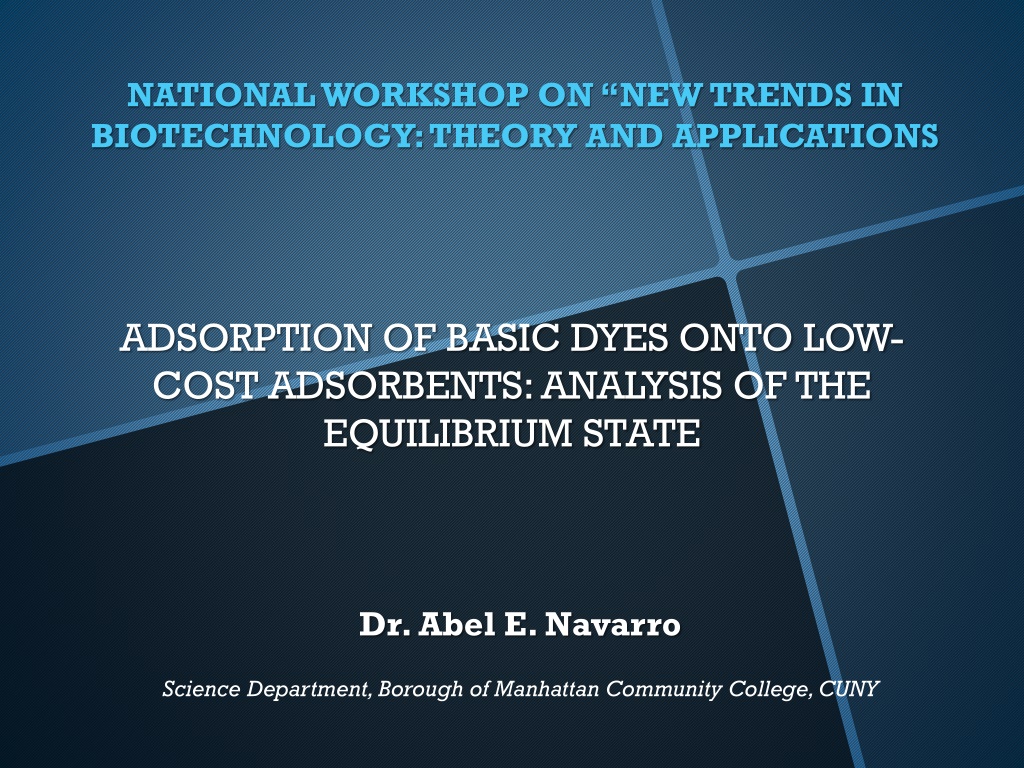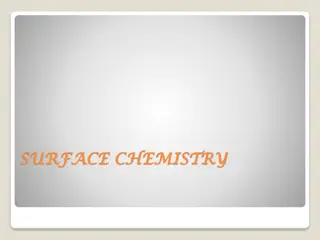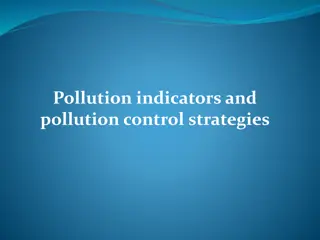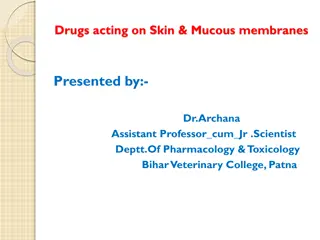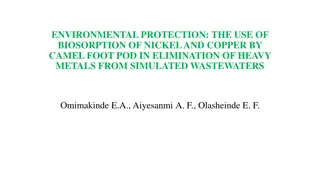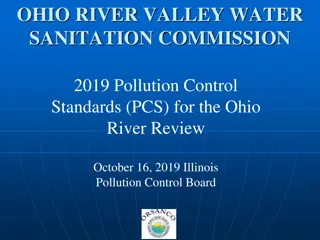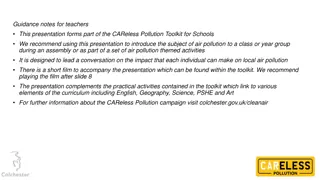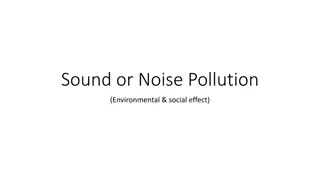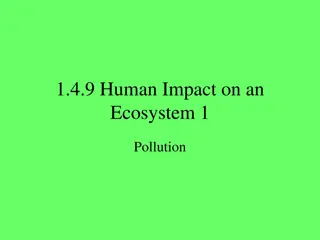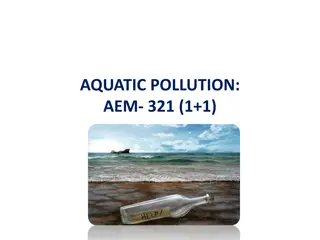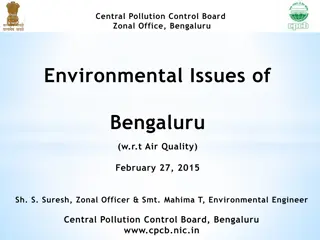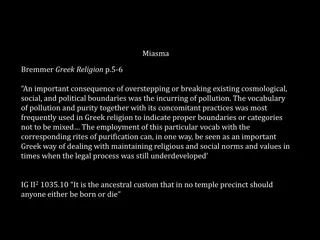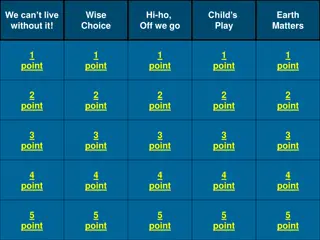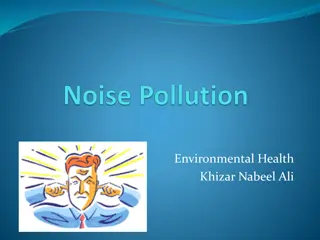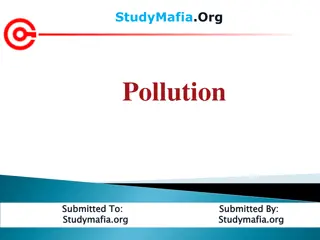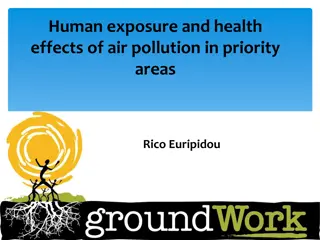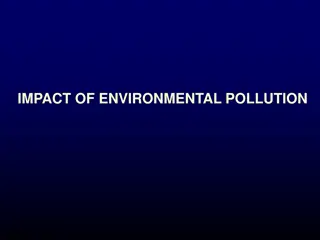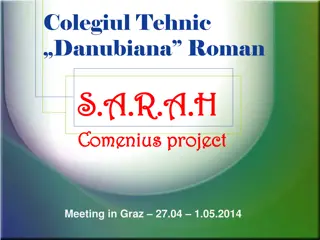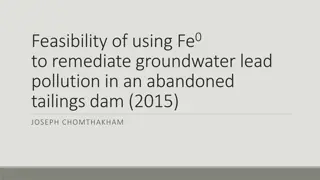Innovative Solutions for Pollution Control Using Natural Adsorbents
Workshop explores new trends in biotechnology for pollutant removal. Focus on adsorption of dyes onto low-cost adsorbents, with analysis of equilibrium state. Various techniques discussed include bioaccumulation, biosorption, and use of non-living biomasses. Emphasis on eco-friendly filtering techniques, pollutant selectivity, and cost-effectiveness of methods.
Download Presentation

Please find below an Image/Link to download the presentation.
The content on the website is provided AS IS for your information and personal use only. It may not be sold, licensed, or shared on other websites without obtaining consent from the author. Download presentation by click this link. If you encounter any issues during the download, it is possible that the publisher has removed the file from their server.
E N D
Presentation Transcript
NATIONAL WORKSHOP ON NEW TRENDS IN BIOTECHNOLOGY: THEORY AND APPLICATIONS ADSORPTION OF BASIC DYES ONTO LOW- COST ADSORBENTS: ANALYSIS OF THE EQUILIBRIUM STATE Dr. Abel E. Navarro Science Department, Borough of Manhattan Community College, CUNY
Color: - Against the natural conception of pure water. It hides other types of pollution. - Prevents the penetration of sunlight into deep layers of water Photosynthesis. - The biological risks have not been totally discarded (carcinogenic and toxic effects).
Use of biological techniques to remove pollutants from air, soil and water. - Bioaccumulation: Living organism - Biosorption: Dead biomass
Use of non-living biomasses to passively remove pollutants Driven by physico-chemical processes Algae, crustacean eggshell, nutshell, fruit peels, fruit seeds, TEALEAVES. Fast kinetics (saturation time). Potential recyclability of waste shells,
Complex structure, mainly formed by polysaccharides have many ways for pollutants to be taken up: - Metabolism dependent. - Non-metabolism dependent.
Competitive performance. Pollutant selectivity. Cost effectiveness. Pollutant recovery. No sludge generation.
Eco-friendly filtering technique. Alternative for using man-made resins (x10 more expensive). Potentially used for air and water.
TARGET POLLUTANTS Basic Blue 99: Naphthoquinoneimine, cationic dye. Amino and hydroxyl groups present. O NH N Cl N N H3C N CH3 CH3 H3C Basic Yellow (BY57) Basic Blue 99 (BB99)
OUR ADSORBENTS Why? High content of functional organic groups such as alcohol (fiber and carbohydrates), carboxylic acids and amines (structural polysaccharides). Widespread use of green tea as a hot/cold drink. Massive collection from green tea industries (i.e. Arizona and other bottled tea-based drinks).
RESULTS Characterization of the Adsorbents by TGA, SEM, FTIR, SURFACE AND POROSITY 0 -2 -4 -6 Mass Loss (%) -8 -10 -12 -14 GT -16 -18 0 100 200 300 400 500 600 0C) Temperature ( FTIR ANALYSIS cm-1 O-H STRETCH 3436 Surface Area (m2/g) 2,735.00 N-H BENDING 1636 Micropore Volume (cm3/g) 0.692 Total Pore Volume (cm3/g) 1.106 C=O STRETCH 1656 C-O STRETCH 1111 C=O STRETCH 1720
pH Effect - Ionization of adsorbent s surface and dye - Higher pH promotes higher adsorption. Mass Effect Minimize amount of adsorbent. Higher adsorption promotes formation of aggregates. - - 100 95 90 90 80 85 70 % ADSORPTION % ADSORPTION 60 80 50 75 40 70 30 65 20 BY57 BB99 BY57 BB99 60 10 0 55 2 3 4 5 6 7 8 0 20 40 60 80 100 120 140 160 180 200 pH Adsorbent Mass (mg)
RESULTS Isotherms were modeled by Langmuir and Freundlich theories. ISOTHERM MODEL BY57 BB99 0.20 BY57 BB99 Langmuir 0.18 0.16 qmax (g/g) b (L/g) 0.06 0.27 Adsorption Capacity (g/g) 0.14 63.29 25.82 0.12 R2 0.979 0.988 0.10 0.08 0.06 Freundlich 0.04 kF (L/g) n 0.23 1.27 0.02 1.829 1.448 0.00 0.02 0.04 0.06 0.08 0.10 0.12 Dye Concentration at Equilibrium (g/L) R2 0.984 0.978
Salinity Effect: - Decreases adsorption due to competition for the adsorption sites. - Higher the charge, the stronger the effect. 95 90 NaCl NaNO3 Ca(NO3)2 NaCl NaNO3 Ca(NO3)2 90 80 85 % BB99 ADSORPTION % BY57 ADSORPTION 70 80 75 60 70 50 65 40 60 30 55 20 50 0.0 0.1 Salt Concentration (mol/L) 0.2 0.3 0.4 0.5 0.0 0.1 Salt Concentration (mol/L) 0.2 0.3 0.4 0.5 BB99 BY57
Presence of Heavy Metals - Large and positively charge ions. - Present in residual waters. 100 Cu(II) Pb(II) Cu(II) Pb(II) 80 % BY57 ADSORPTION % BB99 ADSORPTION 80 60 60 40 40 20 20 0 0 0 10 20 30 40 50 0 10 20 30 40 50 Heavy Metal Concentration (mg/L) Heavy Metal Concentration (mg/L) BB99 BY57
Green Tealeaves have proven to be promising adsorbents for model dyes BY57 and BB99. TGA, FTIR, surface/porosity and SEM studies report advantages of GT as an alternative adsorbent. Langmuir and Freundlich isotherms modeled the adsorption indicating a qmax of 0.06 and 0.27g/g for BY57 and BB99, respectively. Salinity and heavy metals have a negative effect on the adsorption of both dyes, due to competition for adsorption sites.
Acknowledgements Group Members: Michelle Naidoo Habib Zahir Rada Kostadinova Natalia Fernandez Alvaro Sponza San Shairzai Funding: Grant 001-2012-L Oreal-CONCYTEC 2013-BMCC Faculty Development Grant CSTEP, PRISM and LSAMP programs
